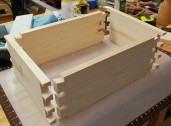Paul Sellers has a really great video on making your own frame saw from a band saw blade or blades available specifically for frame saws. It is a wonderful project that can be done with a minimal amount of tools and material.
I started with a metal bandsaw blade and a few pieces of scrap oak I had around. Typical hack saw blades are only 12″ long. This one is going to be 18″. The extra length should translate to a much faster more comfortable cut. I will also have a lot more fine control on blade tension vs a normal hack saw.
The shorter pieces will make an upright and the long piece will act as a pivot bar in the center. The uprights got a small set of mortises with a rounded relief to let the pivot bar do its pivoting! The bar got a matching tenon on each end with a rounded section. I did the round with a few saw cuts to get it close, then finished with a rasp.
When I got those fitting reasonably well I moved on to the bottom. A saw cut will let the band saw blade in, and a hole set 3/4 of the way over will accept a nail to hold the blade in place.
To hold the string I cut a small notch down, then used a chisel to sculpt both sides into that saw cut. Once roughed in I pulled out the ole spokeshave and went to town. What a fun tool to use. It can be hard to see in the picture, but I did a lot of subtle shaping on the handle side. Being able to hold it, then shape, then hold again is a fast way to make a part like this fit you really well in a short amount of time.
When everything was rounded I assembled, tensioned the bow by twisting the strings with another small scrap of oak, and tried it out on a bar of steel I had around. Very nice! The saw is light and well balanced, and the 18 inches of length meant I could really get into the cut without having to hold back.
Next time I will work harder on making the rounds at the mortise/tenon joint more consistent, but otherwise I am very happy with this. With testing done, I disassembled it, coated everything with BLO, and reassembled when dry. The first picture of this post shows the saw with finished and in a low tension storage state.






























